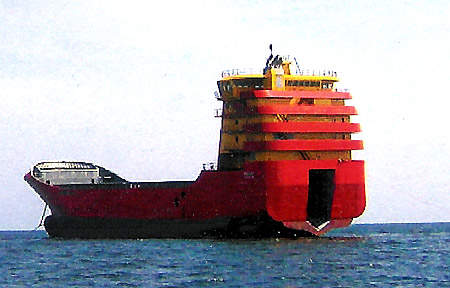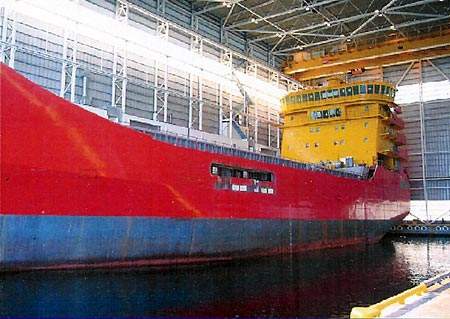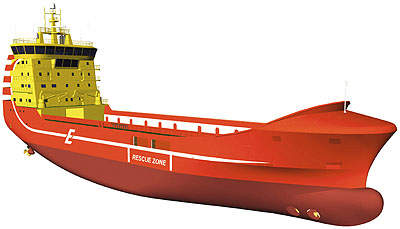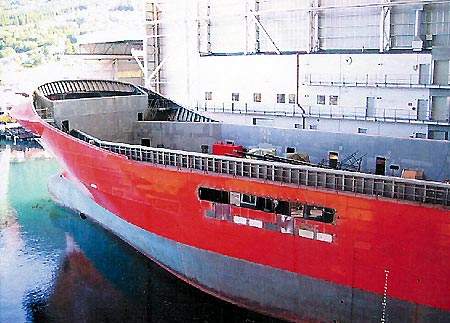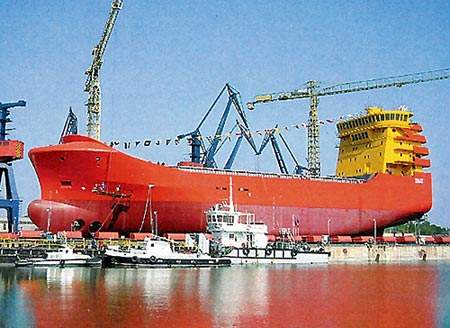This new innovative platform supply vessel is designed to carry out regular supply and cargo transport functions for the oil industry. In a significant departure from many designs, the bridge and accommodation lie at the aft of the vessel, in a similar manner to an oil tanker. According to the designers Vik Sandvik, this is intended to reduce movement and noise, and provide a safer bridge layout (no aft bridge console). It has better hull lines, better DP plot, a simplified cargo area, a safer loading and discharging platform, and a lower building cost.
The Viking Avant has an overall length of 92.7m and a length between perpendiculars of 84.8m. Its breadth is 20.4m and the depth to the first deck is 9m. It has a 7.5m summer draught.
The vessel has a 3,600t gross tonnage and a deadweight of 1,500t at 4.50m depth. Its deadweight at 6m is 3,800t and 6,200t at 7.5m. The deck has a cargo area of 1,170m² and a cargo capacity of 3,900t.
PLATFORM SUPPLY VESSEL CARGO AND STORAGE
The cargo system incorporates an inert gas generator and dry bulk compressors. To load the cargo, there are two knuckle-boom deck cranes – one with a range of 10t at 10m, and the other 3t at 12m. There is also a folding crane, located forward, for hose handling.
The vessel can also store liquid cargo, including a total of 1,400m³ of fuel oil, 1,000m³ of fresh water and 2,300m³ of ballast water / drill water. There are also eight 50m³ dry bulk units and six 125m³ containers of 2.5sg liquid mud, giving a total capacity of 740m³.
It can carry a total of 1,140m³ of liquid mud and 800m³ of brine, as well as 260m³ of mineral oil / base oil.
The Viking Avant also has tanks to store 160m³ of methanol. The vessel has a 30m³ slop tank and a 1,000m³ tank for oil recovery.
ACCOMMODATION AND CREW
Accommodation consists of two two-berth cabins as well as 16 one-man cabins with separate bathrooms, along with a galley, mess and two dayrooms. There is an office, lobby, change room, health / fitness room, hospital, deck stores, deck workshop and garbage handling room. The boilers are manufactured by Pyro.
A Pegasus International high-pressure, single pipe ventilation system, with constant air volume and full heating and air, will provide conditioning throughout the accommodation.
Emergency lifesaving equipment includes a Norwegian Maritime Directorate (NMD)-approved Norsafe man-overboard rescue boat, a telescopic launch / retrieval system and life-saving appliances according to SOLAS.
PROPULSION AND NAVIGATION
Power is provided by four generator sets, each rated at 1,800kW at 1,800rpm. It is linked to a generator with an output of 690V. For emergencies, there will also be a 250kVA generator. All sets will run on marine diesel oil.
The power systems are connected to a pair of ABB steerable pod propulsors featuring fixed pitch, four-bladed propellers turning at a variable RPM. These contra-rotating propellers have an output of 3,000kW each. The propellers have a diameter of 3,300mm, which affords the vessel a speed of 16kt. ABB also supplied the frequency converter, the transformer and the motor for the thrusters.
Manoeuvring is assisted by two Brunvoll tunnel thrusters located forward, each rated at 1,000kW, and an 880kW Brunvoll AR-63 type retractable Azimuth thruster.
Anchoring and mooring are aided by two stockless anchors, each controlled by windlasses / mooring winches. There is also a double mooring winch located aft.
The DP sensor and positioning reference system include three gyro compasses, two wind sensors, two motion reference units, two dGPS/Glonass systems and a Fanbeam system. To minimise roll, there are two passive free-surface effect roll reduction tanks.
The vessel is Norwegian flagged and classified under DnV with the notation +1A1, Supply Vessel, SF, E0, Dynpos AUTR, LFL*, Oil Rec, Clean, COMF-V (3).

